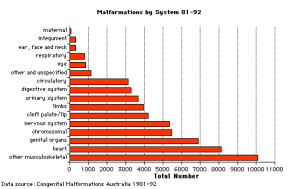Human Abnormal Development: Difference between revisions
No edit summary |
|||
| Line 19: | Line 19: | ||
# Renal Agenesis/Dysgenesis - reduction in neonatal death and stillbirth since 1993 may be due to the more severe cases being identified in utero and being represented amongst the increased proportion of terminations (approximately 31%). | # Renal Agenesis/Dysgenesis - reduction in neonatal death and stillbirth since 1993 may be due to the more severe cases being identified in utero and being represented amongst the increased proportion of terminations (approximately 31%). | ||
# Cleft Lip and Palate - occur with another defect in 33.7% of cases. | # Cleft Lip and Palate - occur with another defect in 33.7% of cases. | ||
"The national collation and reporting of birth anomalies data has been suspended in recent years due to concerns about data quality and comparability." | |||
Variability among states and territories in scope of birth anomalies data collections | |||
sources of birth anomalies notifications | |||
definitions and classifications used | |||
method of data collection | |||
available resources | |||
Variability among the states and territories in the timing and method of the provision of birth anomalies data to the AIHW National Perinatal Statistics Unit (NPSU) for national collation and reporting. | |||
New Australian Birth Anomalies System should be data for birth anomalies detected up to 1 year of age | |||
including data on terminations of pregnancies with birth anomalies | |||
regardless of gestational age (i.e. including less than 20 weeks gestation) | |||
System will initially be based on data from the states able to detect birth anomalies at least up to 1 year of age | |||
NSW, VIC, WA and SA | |||
further extending the period of detection in the future | |||
(Reference: modified from [http://www.aihw.gov.au/ Australian Institute of Health and Welfare (AIHW)]) | |||
== UNSW Embryology Links == | == UNSW Embryology Links == | ||
| Line 24: | Line 41: | ||
* [http://embryology.med.unsw.edu.au/Defect/page3.htm Abnormal Development- Australian Statistics] | * [http://embryology.med.unsw.edu.au/Defect/page3.htm Abnormal Development- Australian Statistics] | ||
== External Links == | |||
* [http://www.aihw.gov.au/ Australian Institute of Health and Welfare (AIHW)] | |||
==Glossary Links== | ==Glossary Links== | ||
Revision as of 14:34, 12 August 2009
A page introducing developmental abnormalities in humans.
Statistics - Top Ten
The ten most frequently reported birth defects in Victoria between 2003-2004 (More? Australian Statistics - Victoria)
- Hypospadias
- Obstructive Defects of the Renal Pelvis
- Ventricular Septal Defect
- Congenital Dislocated Hip
- Trisomy 21 or Down syndrome
- Hydrocephalus
- Cleft Palate
- Trisomy 18 or Edward Syndrome - multiple abnormalities of the heart, diaphragm, lungs, kidneys, ureters and palate 86% discontinued.
- Renal Agenesis/Dysgenesis - reduction in neonatal death and stillbirth since 1993 may be due to the more severe cases being identified in utero and being represented amongst the increased proportion of terminations (approximately 31%).
- Cleft Lip and Palate - occur with another defect in 33.7% of cases.
"The national collation and reporting of birth anomalies data has been suspended in recent years due to concerns about data quality and comparability."
Variability among states and territories in scope of birth anomalies data collections sources of birth anomalies notifications definitions and classifications used method of data collection available resources Variability among the states and territories in the timing and method of the provision of birth anomalies data to the AIHW National Perinatal Statistics Unit (NPSU) for national collation and reporting. New Australian Birth Anomalies System should be data for birth anomalies detected up to 1 year of age including data on terminations of pregnancies with birth anomalies regardless of gestational age (i.e. including less than 20 weeks gestation) System will initially be based on data from the states able to detect birth anomalies at least up to 1 year of age NSW, VIC, WA and SA further extending the period of detection in the future (Reference: modified from Australian Institute of Health and Welfare (AIHW))
UNSW Embryology Links
External Links
Glossary Links
A | B | C | D | E | F | G | H | I | J | K | L | M | N | O | P | Q | R | S | T | U | V | W | X | Y | Z | Numbers
- Dr Mark Hill 2009, UNSW Embryology ISBN: 978 0 7334 2609 4 - UNSW CRICOS Provider Code No. 00098G
